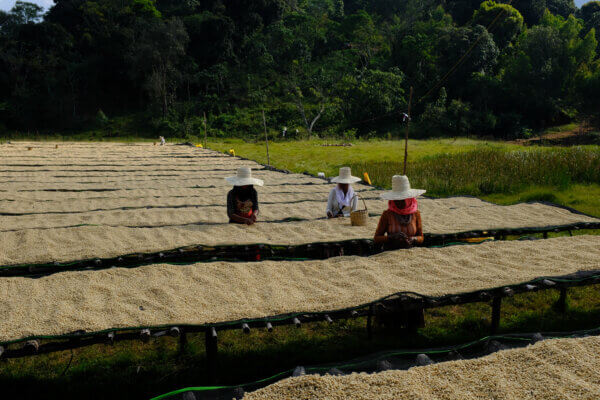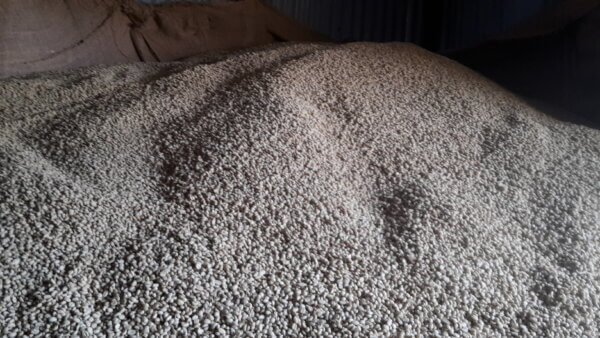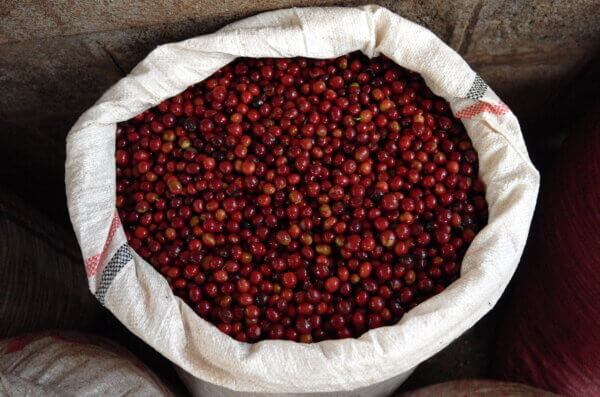Coffee is a living plant, and like other living things, it has an innate life cycle. We’ve talked about age in coffee before—what causes coffee to age, what age tastes like, how to work with it, and what the end of the aging cycle looks like—but here we explore the long bloom that certain coffees, specifically those from Agaro, Ethiopia, embody so beautifully.
In the weeks following arrival, all coffees start out a little bit muted in flavor, then bloom over a period of weeks or months. Agaros are special, continuing to open up for 6+ months after arrival. Cupping these April arrivals now, in November, is a revelation. What was then a distinct but contained white peach note is now full-on juicy yellow peach. Subtle florals then have now evolved to a pronounced jasmine note. It’s a phenomenon we see every year, but one that never fails to amaze.
We talked with Red Fox global lab manager and QC veteran Joel Edwards on the spectacular long blooms of Agaro, what might be causing them, and how to plan for it.
What makes Agaro different

First, some background. Agaro coffees have always formed a core of the Red Fox menu, but our relationship there extends back far before Red Fox was born. Back in 2009 when Red Fox co-founder and CEO Aleco first traveled to meet with Agaro cooperatives, their coffees were flowing into the marketplace undifferentiated and undervalued. Once USAID’s Technoserve project, which focused on improving African coffee farmers’ lives by helping them get better prices for their coffee, established these washing stations with brand-new processing equipment, Aleco saw the unique character of these coffees and invested in developing relationships with their producers, which have grown stronger to this day.
Processing is meticulous in Agaro, even more than with some of our other Ethiopia partners. After Penagos processing equipment mechanically removes most of the fruit and mucilage from the seeds, they soak overnight in fiberglass tanks, allowing any remaining sugars to be fully removed from their surface so that the coffees are perfectly clean by the time they hit the drying beds for the 8+ days they’ll need to dry.
They’re also the earliest Ethiopian coffees we bring in each year, with harvest in January and first shipments arriving as early as February depending on the year. They’re not early-harvest, they’re from Western Ethiopia, which has an earlier growing season.
And how much more special is it that these coffees, which come in first, also hold up the longest?
Unparalleled longevity: still a mystery

Despite our years of curiosity, Joel readily admits we aren’t any closer to a definitive understanding of what exactly makes Agaro coffees hold up so long and shine so brightly so long after harvest—even beyond the long blooms of some of our other Ethiopian favorites. Below are some factors that he thinks might form part of the equation.
Water Activity
Like our other Ethiopia offerings, Agaros showcase ideal water activity and moisture levels towards the low end of the range we look for. Since all Ethiopian coffees tend towards this continued long-bloom process, we know water activity and moisture probably do play a role.
However, because Agaros outlasted certain Guji lots that arrived with similar water activity, we know while it plays a role, water activity can’t account for the whole picture.
Ecopulpers
“Agaro is unusual (if not unique) in Ethiopia in terms of processing equipment,” says Joel. As mentioned above, Technoserve set them up with ecopulpers as well as other state-of-the-art equipment for processing.
But, Joel says, the other origin that we’ve worked in that uses ecopulpers is Costa Rica, which has a fairly average shelf-life. So, we know it’s not just an ecopulper thing.
Logistics
We work hard at having the absolute fastest, cleanest transit routes for all our coffees globally. Joel agrees that logistics play a definitive role in maximizing the shelf-life of any coffee.
“As soon as a coffee is dried, the clock’s ticking,” says Joel. “No matter the origin, if it takes 3 months to get it to the states, that’s 3 months less time it will spend at ideal quality level.”
Transport is a demanding process for coffee to go through: temperature extremes, changes in surrounding humidity and pressure, all stress green coffee. We try to mitigate them as much as possible by a) working with freight companies that have as few as possible trans-shipment routes, b) paying extra for more direct routes, c) working with major lines that are less likely to get their shipments rolled, d) most of all, overcommunicating with trade partners every single step of the way.
But, this is the logistics process we go through with all our coffees. While all coffee have their own life cycle of slightly muted character at first and bloom over time, most of our coffees outside Agaro are pretty much in full bloom on arrival. So fast, clean logistics still don’t account for the disparity.
As we said, the full explanation is still a mystery.
Menu planning for Agaro stamina

Because Agaro is always the first fresh-crop Ethiopian arrival of the year and the last to give up its flavor, it’s an ideal year-round investment. To best manage a position with Agaro’s shelf-life and long bloom taken into account, Joel recommends forward booking these and continuing to buy them until they’re gone. There’s always a diversity of flavors from the different washing stations, and quality is never less than stellar.
They’re iconic fresh Ethiopia in spring and summer, really peaking in fall, and holding that character until the new crop arrives in late winter/early spring.
Flavors then & now

Cupping through our current Agaro position, our whole team as well as roaster partners have been struck by how much these coffees have opened up since they landed.
“When they first started arriving in April, the flavors were all there, but they were a bit muted,” says Joel. “Since arrival, these coffees have opened up and are now hitting their peak. Our average scores keep climbing and the flavors we know these coffees for are becoming louder and more distinct. Duromina has more of that floral lime flavor we love. Nano Genji has a ripe yellow peach note that jumps right out at you. Kolla Bolcha is like biting into candied ginger. If you haven’t tasted these coffees in a while, it’s time to revisit them.”
| Interested in sourcing coffee with us? Reach out at info@redfoxcoffeemerchants.com. To learn more about our work, check out our journal and follow us on Instagram @redfoxcoffeemerchants, Twitter @redfoxcoffee, Spotify, and YouTube. |
